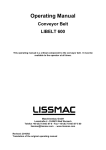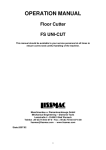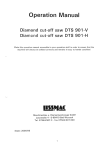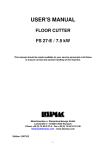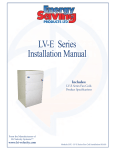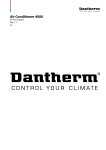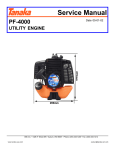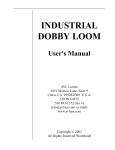Download USER'S MANUAL Introduction
Transcript
USER’S MANUAL Introduction This operating manual should make it easier to learn about the machine and its features. The operating manual contains important information on operating the machine safely, correctly and efficiently. Following the instructions helps prevent accidents, unnecessary repair costs and down time, which extends the machine’s reliability and service life. The operating manual is yet to be supplemented with instructions pertaining to national laws concerning accident prevention and environmental protection. The operating manual must always be accessible on the machine. Every person working on this machine must read and follow the instructions in the operating manual. This includes the following areas: • Operation, including setting-up, troubleshooting, disposal of waste products, product care, disposal of lubrication and auxiliary products. • Servicing (maintenance, inspection, repair) and/or • Transport In addition to the operating manual and to complying with all national and local regulations concerning accident prevention, the general technical regulations for safe and correct operation must also be adhered to. Table of Contents 1. General Safety Precautions 2. Description of Machine 3. Commissioning 4. Transport 5. Operation 6. Dismantling 7. Maintenance and repair 8. Troubleshooting 9. Accessories 1 10. Guarantee 1. General Safety Precautions 1.1 Warning Labels and Symbols used in this Manual Danger! Not following the instructions can result in serious injuries or even death. Caution! Not following the instructions can, under certain conditions, result in injuries. Note! Not following the instructions can result in damage to the machine or other equipment. 1.2 General Safe Operating Procedures Danger! 1.2.1 The machine has been manufactured in keeping with the most recent technology and the recognised safety rules. Nevertheless there may be some risk of a hazard to life and limb of the user or third persons or impairments of the machine and other real assets respectively. 1.2.2 Use the machine only in good working condition and follow all procedures concerning correct and safe operation, as outlined in the manual! This applies specifically to malfunctions that can jeopardise safety! Danger! 1.2.3 The crane is designed exclusively for the raising and lowering of flat elements. The flat elements must not exceed a max. wind surface of 0.64 m². The manufacturers/suppliers accept no responsibility for any damaged caused by incorrect usage. Correct usage includes adherence to the operating instructions and the service and maintenance instructions. 1.3 Organisational Measures 1.3.1 Always keep the operating manual close to the crane and easily accessible Danger! 1.3.2 Observe and give instruction to observe all laws and regulations concerning accident prevention and environmental compliance supplementary to this operating manual! 2 These regulations can, for example, apply to the use of dangerous materials, personal protective equipment, and road traffic laws. Danger! 1.3.3 1.3.4 Any personnel working on the crane must read the operating instructions, especially the chapter on safety precautions, prior to starting work. Reading them while on the job is too late. This applies in particular to any personnel only occasionally working on the crane (e.g. set-up and maintenance crews). Carry out at least occasional spot checks to ensure that personnel are working in a safe and conscientious manner and adhering to the instructions in the operating manual! Caution! 1.3.5 Use personal protective equipment whenever necessary or if required by regulations! Danger! 1.3.6. Observe all safety instructions and danger warnings located on the crane! Danger! 1.3.7 Make sure that all safety instructions and danger warnings on the crane are always legible! Danger! 1.3.8 Stop the crane immediately and notify appropriate office/personnel if there are any safety-related changes in the crane or its manner of operation! Danger! 1.3.9 Do not carry out any modifications, extensions or conversions to the crane without prior permission from the manufacturers/suppliers! Danger! 1.3.10 Only use original spare parts! Danger! 1.3.11 Adhere to inspection deadlines as prescribed or specified in the operating instructions! An annual inspection by a qualified agency (Technical Inspectorate TÜV – or the manufacturers) is mandatory! 1.3.12 The crane must be cleaned thoroughly prior to inspection. 1.3.13 An inspection logbook must be kept for the crane in which the annual inspections are to be recorded in writing. 1.3.14 All crane models, excl. 300/400 and 300/400 T, must be subjected to an additional main inspection by an appointed technical Inspectorate (BG, TÜV) every four years as well as in year 14 and 16 of operation, and afterwards yearly. Danger! 1.3.15 The main power supply plug must be disconnected prior to carrying out any maintenance or repair work! 1.4 Qualification and selection of personnel; fundamental responsibilities Danger! 1.4.1 Personnel being permitted to work on their own on the crane must be over 18 years of age, instructed in the operation of the crane and have been appointed in writing with the operation of the crane by the owner. 3 Danger! 1.4.2 Unnecessary loitering on moving parts or within the movement range of the crane is forbidden! Danger! 1.4.3 Operating personnel must ensure at all times when moving the crane that they are not endangering themselves or anyone else. Danger! 1.4.4 Work on electrical equipment on the machine may only be carried out by a qualified electrician or by an instructed person under the supervision of a qualified electrician in compliance with respective regulations for electrical equipment. Danger! 1.4.5 Personnel undergoing training, apprentices or new employees must be kept under constant supervision by an experienced operator if working on the machine! 1.5 Safety instructions for specific operating phases 1.5.1 Normal operation 1.5.1.1 Any forms of working that represent a safety risk are forbidden! Danger! 1.5.1.2 Take steps to ensure that the crane is only used when in a safe and operational state! 1.5.1.3 Check the crane at least once a shift for visible signs of damage and faults! Any changes (including any to operation) must be reported at once to the appropriate office/personnel! If necessary, switch the machine off at once and secure! Danger! 1.5.1.4 Stop the crane immediately and secure if their are any functional problems! Rectify any faults immediately! Danger! 1.5.1.5 The crane must be standing on a clean, horizontal and sound base capable of bearing the crane. The max. wheel pressure is 14 kN. Danger! 1.5.1.6 Connecting the crane to the power circuit is forbidden if there is no earth-leakage circuit breaker (e.l.c.b.) in the power supply line or the distributor box. Danger! 1.5.1.7 The crane must be taken down if wind force 7 (15 m per sec.) or greater prevails. Danger! 1.5.1.8 Transporting people on the crane is forbidden! Danger! 1.5.1.9 Loitering underneath suspended loads is forbidden. Danger! 1.5.1.10 Only ever use suitable and tested hoisting gear (stone tongs). 1.5.2 Extracurricular work while using the machine, maintenance/repair work as well as troubleshooting; waste disposal 4 Caution! 1.5.2.1 Adjustment, maintenance and service activities and periods, including details on exchanging parts/components/assemblies, must be observed as specified in the operating instructions! This work may only be carried out by qualified technicians! Caution! 1.5.2.2 Notify operating personnel prior to commencing extracurricular and/or repair work! Appoint a supervisor! Danger! 1.5.2.3 If the crane has been turned off completely for maintenance or repair work, secure it against being turned back on again unexpectedly! Note 1.5.2.4 Before cleaning the crane with water or other detergents, cover/seal any openings where water/steam/detergent penetration is not permitted for safety or functional reasons. This applies in particular to electromotors, switches and plug connections. Note 1.5.2.5 Remove the covers/seals again completely when cleaning work is finished! Danger! 1.5.2.6 Retighten any screw connections which may have come loose during maintenance and repair work! Danger! 1.5.2.7 If the removal of protective devices on the machine was necessary for set-up, maintenance or repair work, they must be re-fitted again immediately upon completion of the work and tested to ensure that they are functioning properly! 1.5.2.8 Make sure that operating and auxiliary materials as well as replaced parts are disposed of in a safe and environmentally friendly manner! 1.6 Precautions for special types of danger 1.6.1 Electrical power Danger! 1.6.1.1 Only use original fuses with the electrical current for which they were designed! Turn the crane off immediately if encountering any faults in the power supply! Danger! 1.6.1.2 Wait until the crane has been disconnected from the power supply circuit before carrying out any maintenance or repair work! Danger! 1.6.1.4 The machine's electrical equipment must be inspected/checked regularly. Any faults, such as loose connections or damaged cables, must be repaired immediately. 1.6.2 Dust 1.6.2.1 Observe any local regulations if working in small rooms/areas! 1.6.3 Noise 1.6.3.1 Continuous sound pressure level of below 70 dB(A)! 5 1.7 Transport Danger! 1.7.1 Use twin suspension gear with sufficient carrying capacity if moving the crane. Danger! 1.7.2 Have an experienced supervisor coordinate the lifting process! Danger! 1.7.3 Only lift the crane in proper manner using hoisting gear and in compliance with the operating instructions (attachment points for hoisting tackle etc.)! Danger! 1.7.4 Only use appropriate transportation vehicle with adequate carrying capacity! Danger! 1.7.5 Secure the load properly. Use the appropriate attachment points! Danger! 1.7.6 Disconnect the crane from the power supply even if only moving the crane a small distance! Reconnect the crane correctly to the power supply before restarting! Danger! 1.7.7 Always observe the instructions in the operating manual when restarting! 2. Description of the machine 2.1 List of components Pos. 1 – Undercarriage Pos. 2 – Wheel drive Pos. 3 – Ballast Pos. 4 – Swivel frame Pos. 5 – Hydraulic unit Pos. 6 – Tower - outer Pos. 7 – Tower - inner Pos. 8 – Boom Pos. 9 – Trolley Pos. 10 – Chain hoist Pos. 11 – Operator control unit Pos. 12 – Cylinder support Pos. 13 – Ballast support 6 Pos. 14 – Rotary drive Pos. 15 – Tensioning cable Pos. 16 – Swivel lock 2.2 Accessories Pos. 17 – Bolting 2.3 Safety devices Pos. 12 – Cylinder support Pos. 15 – Tensioning cable Pos. 16 – Swivel lock 2.4.Technical details Lifting capacity Length of boom Hook height Total weight Ballast 300 400 300 TDP 400 TDP 300 kg (660 lbs.) 5m 4.5 m 1.500 kg 730 kg 400 kg (880 lbs.) 5m 4.5 m 1780 kg 1070 kg 300 kg (660 lbs.) 5m 4.5 / 6 m 1.630 kg 730 kg 400 kg (880 lbs.) 5m 4.5 / 6 m 1910 kg 1070 kg 300 TDP/EL 300 kg (660 lbs.) 5m 4.5 / 6 m 1.780 kg 730 kg 400 TDP/EL 400 kg (880 lbs.) 5m 4.5 / 6 m 2060 kg 1070 kg Transportation dimensions Length Width Height 6.7 m 2.1 m 2.0 m 6.7 m 2.1 m 2.0 m 6.7 m 2.1 m 2.0 m Swivelling radius 1.5 m Max. wheel 14 kN pressure 1.5 m 14 kN 1.5 m 14 kN Chain hoist Lifting capacity Lifting speed Output Current consumption 300 kg (660 lbs.) 2.0 / 8.0 m/min. 0.11 kW 0.5 kW 0.8 A 1.3 A 400 kg (880 lbs.) 2.0 / 8.0 m/min. 0.18 kW 0.75 kW 0.95 A 2.1 A 300 kg (660 lbs.) 2.0 / 8.0 m/min. 0.11 kW 0.5 kW 0.8 A 1.3 A 7 400 kg (880 lbs.) 2.0 / 8.0 m/min. 0.18 kW 0.75 kW 0.95 A 2.1 A 300 kg (660 lbs.) 2.0 / 8.0 m/min. 0.11 kW 0.5 kW 0.8 A 1.3 A 400 kg (880 lbs.) 2.0 / 8.0 m/min. 0.18 kW 0.75 kW 0.95 A 2.1 A Operating voltage 400 V 400 V 400 V 400 V 400 V 400 V Drive motor Output Current consumption Operating voltage 0.55 kW 1.8 A 0.55 kW 1.8 A 400 V 400 V 300 Hydraulic unit output Current consumption Operating voltage 300 TDP 0.31 kW 1A 400 V Swivel motor Output 0.25 kW Current consumption 0.75 A Operating voltage 400 V Trolley Output Current consumption Operating voltage 0.37 kW 1.75 A 230 V 3. Commissioning Important! Before commissioning the cranes with radio control, the storage battery must be loaded! Danger! 3.1 Always place the crane on a horizontal, clean and sound surface capable of bearing the load (max. wheel pressure 14 kN) Danger! 3.2 Extending the tower (only on 300/400 TDP and 300/400 TDP/EL) - Lower ballast supports (pos. 1) and clamp tight - Mount stay cable (pos. 2) with shackle (pos. 3) on boom - Remove bolt (pos. 4) - Extend the tower using crank handle (pos. 5) - Insert bolt and secure 3.3 Erecting the tower - Connect operating control unit (pos. 6) 8 Danger! - Insert the bolt (pos. 7) into the lower hole on the crab - Remove the bolt (pos. 8) from the support pipe - Insert the feed cable in the lower control box - Push the switch “Up” at the upper control box, until the tower is righted (support tube until stopper) - Insert the bolt (pos. 8) in the hole (pos. 11) and secure - Raise ballast supports (pos. 1) (only on 300/400 TDP and 300/400 TDP/EL) - The crane can be swivelled by undoing the swivel lock (pos. 12) 3.4 Wheel drive (only on 300/400 TDP and TDP/EL - Remove securing pin (pos. 14) ∗ Motor swivels on the gearwheel - Insert tow bar in holder - Brake (pos. 15) must be released 3.5 Pushing in swivel motor (only on 300/400 TDP/EL) Note! - Undo the swivel lock (pos. 12) - Raise swivel motor and position between the rubber buffers with bolt (pos. 16) Important! Do not use force to push in motor – if necessary, turn upper sections slightly until the motor can be pushed in easily! 4. Transport Danger! 4.1 Transport position includes: - Swivel lock (pos. 12) is engaged and secured with lock - Support pipe is secured with bolt (pos. 8) - Trolley is locked in place with bolt (pos. 7) - Drive motor must not be in operating position (bolt 14 is inserted) 4.2 Transport possibilities - Crane is pulled by the tow bar - Transport with fork lift truck (fork lift rings – pos. 18) - Reposition with construction crane (crane rings – pos. 19) IMPORTANT! Use twin suspension gear with sufficient carrying capacity! 9 4.3 The crane can be moved in an erected state by a construction crane using the rings (pos. 20). 5. Operation 5.1 Safety Attention! The operation of the crane is just allowed due to the size of the elements according to a certain wind force (see 2.4). - Only use suitable and tested stone tongs for lifting the stones - Loitering underneath suspended loads is forbidden! - Do no leave any suspended loads unattended on the crane - The crane can be swivelled through 360° by undoing the swivel lock (pos. 12) 5.2 Handling the operator control unit (see "9. Accessories") 5.3 Operating the trolley unit without motor ( 300 TDP/EL) - Undo the clamping lever (pos. 22) - Pull back the catch (pos. 23) - Tighten the clamping lever (pos. 22) 6. Dismantling - Erect ballast support (pos. 1) (only necessary if dismantling from an extended operating height of 6 m) - Remove securing bolt (pos. 8) from hole (pos. 11) - Open lowering valve a little (only by hand pump) or press lowering valve (pos. 17) to the right (TDP and DK) - Observe the lowering movement – the speed can be regulated using the hand pump with the lowering valve. - Insert securing bolt (pos. 8) in the lower hole and secure in place Important! Resetting the tower extension - Remove securing bolt (pos. 4) 10 - Wind the tower down using the crank handle (pos. 5) - Insert the securing bolt (pos. 4) and secure in place - Fasten stay cable (pos. 2) with shackle (pos. 21) - Raise ballast supports (pos. 1) 7. Maintenance and repair 7.1 Maintenance - The main power supply plug must be removed before starting any maintenance or repair work Maintenance work daily weekly monthly Lubricate grease nipples ∗ Turntable ∗ Trolley X X Apply grease ∗ Gearwheels on wheel drive X Spray with chain spray ∗ Tower/boom connection ∗ Tower/swivel arm connection X X Check hydraulic system for leaks annually X Check electricity cables for damage X Visual inspection of stay cable, shackle and clamping lock for cracks Clean crane thoroughly X X Regular inspection by qualified technician Grease lubrication points (pos. before every new task X X 11 25) with lithium grease Change hydraulic oil X SELS chain hoist see SELS chain hoist operating instructions! 7.2 Hydraulic oil IMPORTANT! The unit is filled by us at the works with "BP-Batran hydraulic oil HV-46"! An oil change should be carried out once a year. The following types of oil can be used depending on operating conditions: Operating conditions Ambient temperature Designation to ISO-VG DIN 51 519 Kinematic viscosity range at 40 °C Designation to DIN 51 502 Normal conditions Difficult conditions below 0 °C 0/30 °C above + 30 °C below 0 °C 0/30 °C above + 30 °C VG 32 VG 40 VG 68 VG 32 VG 46 VG 68 28.8-35.2 mm²/s (cSL) 41.4-50.6 mm²/s (cSl) 61.2-74.8 mm²/s (cSl) 22.8-35.2 mm²/s (cSl) 41.4-50.6 mm²/s (cSl) 61.2-74.8 mm²/s (cSl) HL 32 HL 48 HL 68 HLP 32 HLP 48 HLP 68 Aral Vitam GF 32 Aral Vitam GF 46 Aral Vitam GF 68 Aral Vitam GF 32, Aral Vitam DE 32 Aral Vitam GF 46, Aral Vitam DE 46 Aral Vitam GF 88, Aral Vitam DE 88 BP Energol HL 32 BP Energol 46 BP Energol RC 68 BP Energol HLP 32, BP Energol HLP-D 32, BP Energol SHF 32 BP Energol HLP 46, BP Energol HLF-D 46, BP Energol SHF 46 BP Energol HLP 68, BP Energol HLP-D 68 CASTROL HYSPIN VG 32 CASTROL HYSPIN VG 46 CASTROL HYSPIN VG 68 CASTROL HYSPIN AWS 32 CASTROL HYSPIN AWS 46 CASTROL HYSPIN AWS 68 ESSTIC 32 ESSTIC 46 ESSTIC 68 NUTO H 32 NUTO H 46 NUTO H 68 RENOLIN DTA 10 RENOLIN DTA 15 RENOLIN DTA 20 RENOLIN MR 10, RENOLIN B 10 RENOLIN MR 15, RENOLIN B 15 RENOLIN MR 20, RENOLIN B 20 Mobil D.T.E. Oil Light Mobil D.T.E. Oil Medium Mobil D.T.E Oil Heavy Medium Mobil D.T.E 24 Mobil D.T.E 25 Mobil D.T.E 26 12 Rando Oil 32 Rando Oil 46 Rando Oil 68 Rando Oil HD A-32, Rando Oil HD AZ-32 Rando Oil HD B-46 Rando Oil HD C-68, Rando Oil HD CZ-68 ZET-GE GWA 1 ZET-GE DHG 32 ZET-GE GWA 2 ZET-GE DHG 46 ZET-GE GWA 3 ZET-GE DHG 68 ZET-GE HLP 32 ZET-GE DHG 32 ZET-GE HLP 46 ZET-GE DHG 46 ZET-GE HLP 68 ZET-GE DHG 68 These are some examples of brand-name hydraulic oils. Similar oils can also be used. The guarantee for their suitability of use is to be provided by the supplier. 8. Troubleshooting - The power supply plug must be removed before carrying out any maintenance or repair work. Fault Cause Remedy Crane mast cannot be erected upright Not enough hydraulic oil in the tank Top up with oil (see "Recommendations for oil") Mast lifts jerkily Air in the hydraulic system Have system bled by the manufacturer or trained personnel Unit not running (TDP) Supply line or motor fault May only be repaired by a qualified electrician The tower does not move when the "up" button is pressed although the unit is running (TDP) Pump running in wrong rotational direction Turn round the poles on the phase reversal socket for the power supply Securing bolt has not been removed Remove securing bolt Crane cannot be dismantled Securing bolt not removed Remove securing bolt Turntable sluggish No lubrication Apply lubricating grease Wheel drive not running Drive motor not connected Connect motor (see 3.5) Brake not released Release brake Motor not running May only be repaired by a qualified electrician Boom setting wrong Raise boom tip using clamping lock (behind ballast) A raised load runs to the end of the boom by itself 13 with radio control If the sender is damaged you could operate the chain hoist function by a one hand steering gear. All other functions are still out of operation. Required measures: Remove dummy plug at the chain hoist and connect it with one hand steering gear. Remove both plugs at the switch box and connect it with each other. 10. Guarantee The guarantee time is 12 months. The following wearing parts you will get only in guarantee, when the wearing is not due to working conditions. Wearing parts are parts, which will be worn out in working conditions due to intended use of a machine. The time of wearing is not defineable in an uniform way, it depends on their application intensity. The wearing parts for each specific machine has to be attended, adjusted and if necessary exchanged in accordance to the user’s manual of the producer. For wearing due to working conditions there is no guarantee. • • • • • • • • • • • • • • • • • • • • • • • • • • Advance- and driving elements as toothed racks, toothed wheels, pinions, spindles, spindle nuts, spindle bearings, ropes, chains, chain wheels, belts Washers, cables, hoses, collars, plugs, clutches and switches for pneumatic, hydraulic, water, elektricity, fuel guidance elements as guiding joints, guiding bushes, guiding rails, rolls, bearing, antislipping devices flushing head seal sliding- and rolling bearing, which are not running in an oil-bath rotary shaft seal and sealing elements friction- and overload clutches, brake gears graphite brush, collectors potentiometer control and manual control elements fuses and lamps process materials fixing materials as plugs, anchor and screws bowden wires lamellars membranes spark plugs, glow plugs parts of reversing starter as start by rope, start by handle, start by roll, start by spring sealing brush, packing rubber, splash guard rags filter all types driving-, deflection roller and roller lining protection elements for rope lays running- and driving wheels water pumps transport roller for cutting material drilling-, parting-off- and cutting tools conveyor belt 14 • • • rubber stripes needled felt protection energy storage 15 9 2. Machine description 2.1 Component overview Item 1 – chassis Item 29 – forklift eyes Item 2 – drive unit Item 30 – crane eyes Item 3 – ballast Item 31 – crane eyes (built onto the crane) Item 4 – pivoting frame Item 32 – clamping lever (detail B) Item 5 – hydraulic assembly Item 33 – pull carriage (detail B) Item 6 – outer tower Item 34 – exhaust valve Item 7 – inner tower Item 35 – shackle Item 8 – arm Item 36 – stop (detail C) Item 9 – carriage Item 37 – lubricant nipple bearing (detail A) Item 10 – chain hoist Item 11 – pendant control panel Item 12 – cylinder support Item 13 – ballast support 2.2. Safety guards Item 14 – stay Item 15 – pivot interlock Item 12 – cylinder support Item 16 – shackle Item 14 – stay Item 17 – bolts Item 15 – pivot interlock Item 18 – crank Item 26 – safety plug – drive Item 19 – plug bolts – carriage Item 27 – brake Item 20 – plug bolts – support pipe (lower hole) Item 21 – shackle Item 22 – plug Item 23 – plug bolts – support pipe (upper hole) Item 24 – anti-rotation device Item 25 – plug Item 26 – safety plug – drive Item 27 – brake Item 28 – bolts (detail A) 8 2.4.Technical details Lifting capacity 400 300 TDP 400 TDP 400 TDP/EL 400 kg 300 kg 400 kg 400 kg (880 lbs.) (660 lbs.) (880 lbs.) (880 lbs.) Length of boom 5m 5m 5m 5m Hook height 4.5 m 4.5 / 6 m 4.5 / 6 m 4.5 / 6 m Total weight 1780 kg 1.630 kg 1910 kg 2060 kg Ballast 1070 kg 730 kg 1070 kg 1070 kg Transportation dimensions Length 6.7 m 6.7 m 6.7 m Width 2.1 m 2.1 m 2.1 m Height 2.0 m 2.0 m 2.0 m Swivelling radius 1.5 m 1.5 m 1.5 m Max. wheel pressure 14 kN 14 kN 14 kN 400 kg 300 kg 400 kg 400 kg (880 lbs.) (660 lbs.) (880 lbs.) (880 lbs.) 2.0 / 8.0 m/min. 2.0 / 8.0 2.0 / 8.0 2.0 / 8.0 m/min. m/min. m/min. Chain hoist Lifting capacity Lifting speed Output Current consumption Operating voltage 0.18 kW 0.11 kW 0.18 kW 0.75 kW 0.5 kW 0.75 kW 0.18 kW 0.75 kW 0.95 A 0.8 A 0.95 A 0.95 A 2.1 A 1.3 A 2.1 A 2.1 A 400 V 400 V 400 V 400 V Drive motor Output - 0.55 kW 0.55 kW Current consumption - 1.8 A 1.8 A Operating voltage - 400 V 400 V 300 TDP 0.31 kW 1A 400 V Hydraulic unit output Current consumption Operating voltage Swivel motor Output - - 0.25 kW Current consumption - - 0.75 A Operating voltage - - 400 V Trolley Output 0.37 kW Current consumption 1.75 A Operating voltage 230 V


















